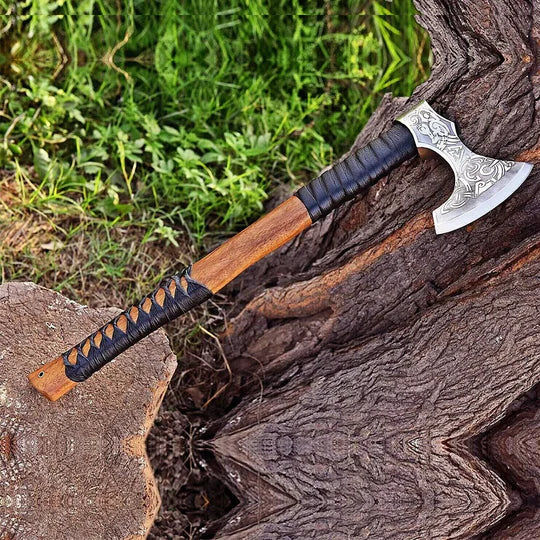
Looking for a Viking Axe Real Hatchet? Explore the World of Viking Axes
Table of Contents
1. Introduction
2. Origins of the Viking Axe
3. Evolution of the Viking Axe
4. Types of Viking Axes
- 4.1. Battle Axes
- 4.2. Norse Axes
- 4.3. Hand-Forged Axes
- 4.4. Historical and Antique Axes
5. Craftsmanship and Design
6. Symbolism and Cultural Significance
7. The Role of the Viking Axe in Warfare
8. Modern Interpretations and Collectibles
9. Maintaining and Caring for Your Viking Axe
10. Conclusion
1. Introduction
In the annals of history, few weapons evoke the same sense of power, prowess, and tradition as the Viking axe. Synonymous with the ferocious warriors of the Norse sagas, the Viking axe has carved its place in legend and lore. In this comprehensive guide, we delve into the rich tapestry of the Viking axe, exploring its origins, evolution, types, craftsmanship, and enduring cultural significance.
2. Origins of the Viking Axe
The roots of the Viking axe trace back to the early medieval period, when Scandinavian warriors relied on axes not only as tools but also as formidable weapons of war. Initially fashioned for practical purposes such as chopping wood and building, the Viking axe soon found its place on the battlefield, becoming an indispensable tool of conquest for Viking raiders.
3. Evolution of the Viking Axe
Over centuries of warfare and craftsmanship, the Viking axe Real Hatchet underwent a remarkable evolution. From rudimentary tools to finely crafted instruments of death, the design and construction of the Viking axe evolved in tandem with the changing tides of history. Innovations in metallurgy and forging techniques led to the creation of axes that were both deadly and durable, capable of cleaving through armor and bone with ease.
4. Types of Viking Axes
The Viking axe comes in various forms, each tailored to suit a specific purpose on the battlefield or in daily life.
4.1. Battle Axes
At the forefront of Viking warfare stood the mighty battle axe. Characterized by its large, double-edged blade and elongated haft, the battle axe was the weapon of choice for Viking warriors in close combat. With its devastating cutting power and intimidating presence, the battle axe struck fear into the hearts of enemies and became a symbol of Viking martial prowess.
4.2. Norse Axes
Norse axes, also known as bearded axes, featured a distinctive elongated blade with a pronounced hook or beard at the lower end. This design allowed for greater versatility in combat, enabling warriors to deliver powerful downward blows or hook their opponents' shields and pull them off balance.
4.3. Hand-Forged Axes
Crafted with meticulous attention to detail by skilled blacksmiths, hand-forged axes were prized possessions among Viking warriors and chieftains. These axes were often adorned with intricate carvings and runes, reflecting the craftsmanship and artistry of their creators.
4.4. Historical and Antique Axes
Preserved through the ages, historical and antique Viking axes offer a glimpse into the weapons of yesteryear. From ceremonial axes buried with Viking chieftains to battle-worn relics recovered from archaeological sites, these axes serve as tangible links to the past, reminding us of the trials and triumphs of the Viking age.
5. Craftsmanship and Design
Central to the allure of the Viking axe is its craftsmanship and design. Crafted with precision and skill, each axe tells a story of the hands that forged it and the battles it witnessed. From the intricately patterned Damascus steel of a ceremonial axe to the rugged simplicity of a battle-worn war axe, the craftsmanship of the Viking axe is a testament to the ingenuity and artistry of its makers.
6. Symbolism and Cultural Significance
Beyond its utility as a weapon of war, the Viking axe holds deep symbolic and cultural significance. In Norse mythology, the axe was associated with gods such as Thor, the thunder god, and Odin, the all-father. As a symbol of strength, courage, and protection, the axe held a revered place in Viking society, adorning banners, jewelry, and even gravestones.
7. The Role of the Viking Axe in Warfare
In the hands of a skilled warrior, the Viking axe was a fearsome weapon capable of turning the tide of battle. Whether wielded in single combat or as part of a shield wall formation, the axe was a versatile tool of destruction, capable of delivering devastating blows with deadly precision.
8. Modern Interpretations and Collectibles
While the age of Viking conquest may be long gone, the legacy of the Viking axe lives on in modern interpretations and collectibles. From meticulously crafted replicas to artistic interpretations inspired by Norse mythology, the Viking axe continues to captivate the imagination of enthusiasts and collectors around the world.
9. Maintaining and Caring for Your Viking Axe
To ensure the longevity and performance of your Viking axe, proper maintenance and care are essential. Regular sharpening, oiling, and storage in a dry environment will help prevent rust and corrosion, preserving your axe for generations to come.
10. Conclusion
In conclusion, the Viking axe stands as a testament to the ingenuity, craftsmanship, and martial prowess of the Norse warriors who wielded it. From humble beginnings as a tool of survival to its iconic status as a symbol of Viking might, the axe has carved its place in history as one of the most enduring symbols of the Viking age. Whether displayed proudly in a collection or wielded in reenactments, the Viking axe continues to inspire awe and admiration, reminding us of the indomitable spirit of the Viking people.






